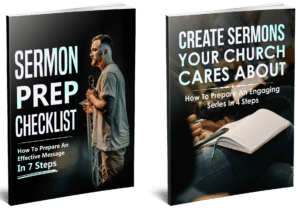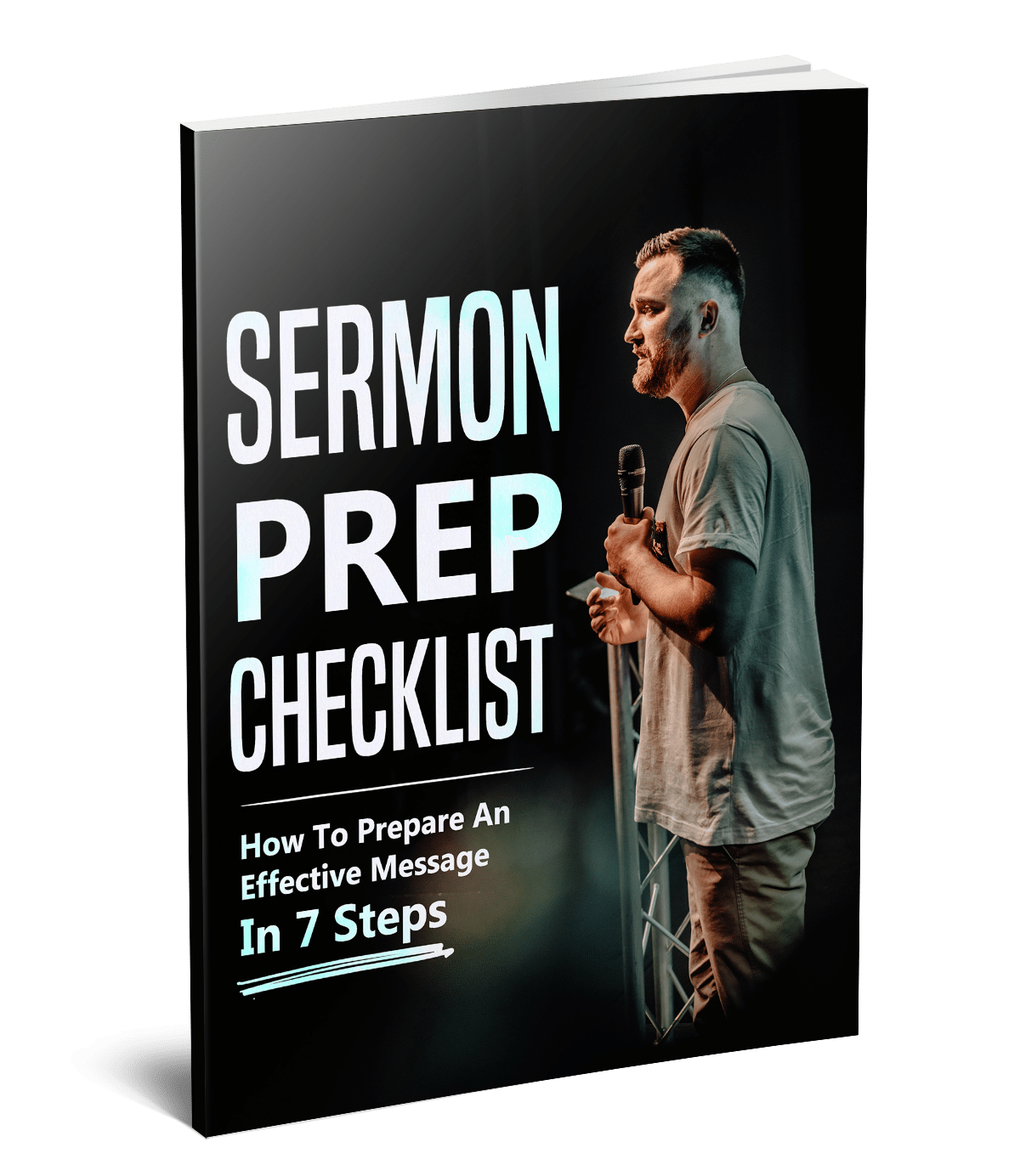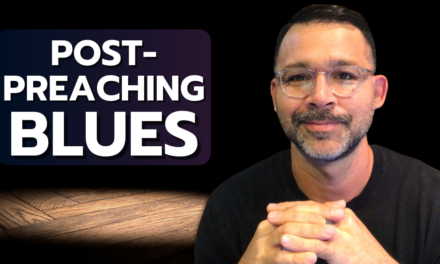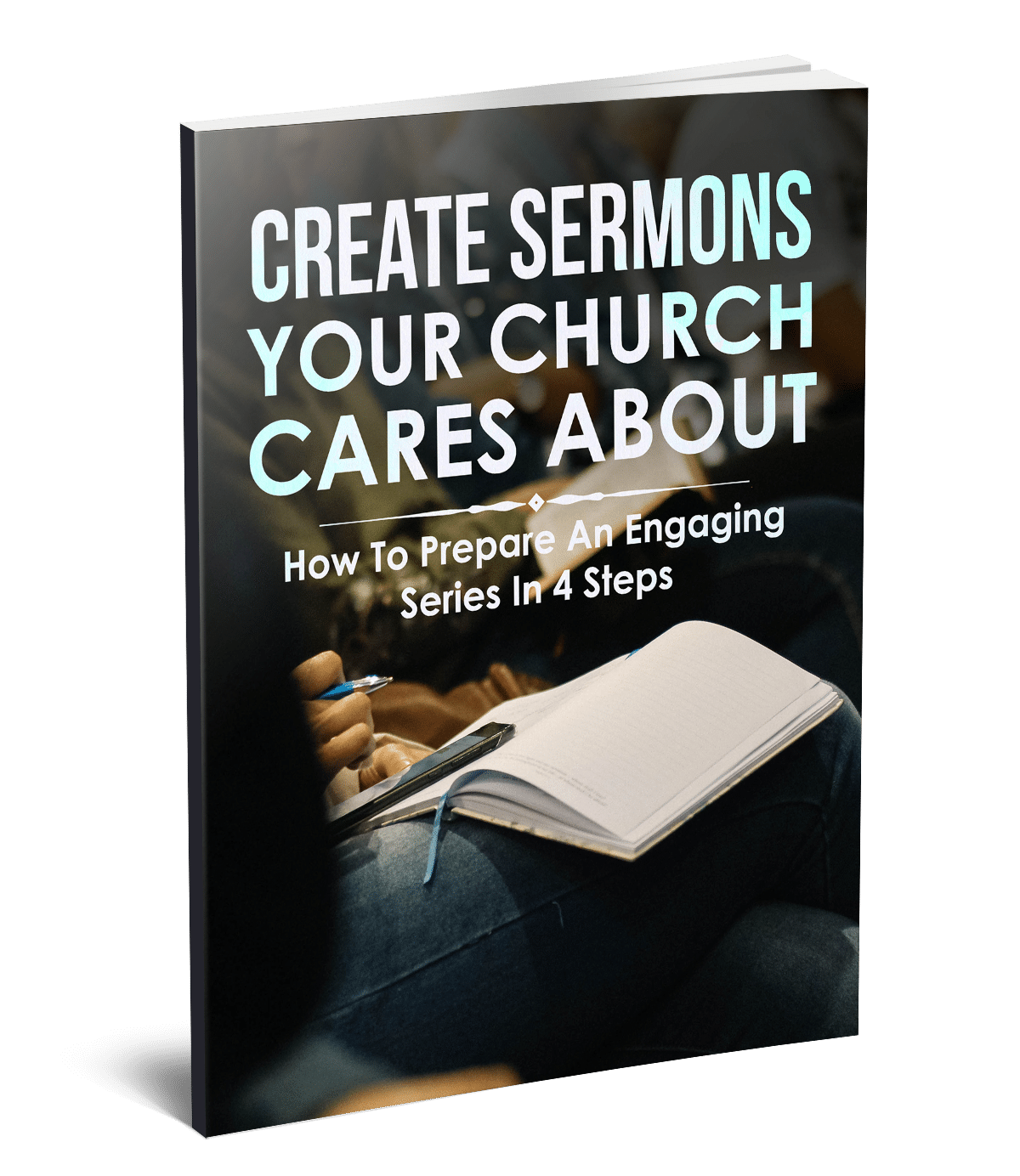Preaching and teaching are, first and foremost, a calling. However, there are some basic guidelines that I’ve found helpful over the years as I’ve worked to prepare sermons almost every week. I like to use this sermon preparation worksheet to develop upcoming messages.
Remember that you probably have a method of note-taking and providing mental cues that work best for you. If so, stick with what works for you in those areas. The worksheet is only a guide to help you prepare for the message you want to convey, not change your unique delivery and the particular ways God uses you to share His heart.
Save yourself and your team time by downloading the sermon preparation worksheet. As a bonus, you’ll also receive the Sermon Series Planning Worksheet!
Click the button below to purchase the bundle using the easy-to-use digital download and get immediate access to the worksheets and a free bonus!

Below is an outline of each step included in the sermon preparation worksheet, with question prompts.
7-Step Sermon Preparation Guide
Step 1: Prayer: What does God want me to say?
There are times that I wrestle with what to preach about. Similarly, I flip back and forth between bible verses and watch other preachers on youtube too. Eventually, I humbly realized that I have probably not spent enough time asking God what He thinks I should share.
Prayer is the first step to delivering a compelling message in any setting. Start there!
Step 2: Purpose: Why is this message important?
As you prepare to deliver a sermon, it is helpful to ask yourself questions like:
If people do not hear this message, what will happen?
What do people need or long for as it relates to this sermon?
What action step or decision should I lead people toward to make their lives better?
Simon Sinek once said that infusing a message with passion requires two things from him: 1. To only speak about things he cares about, and 2. To only talk about things that he understands.
Answering questions like those above will help you have a clear vision of why sharing it matters and, as a result, connect more deeply with the heart of the message.

Step 3: Problem: What problem does this solve?
As preachers, we want people to engage with what we’re saying. Of course, we want to inspire others to change and increase the desire for God and His Word. Unfortunately, most people are tired and in a hurry. They want answers that will immediately help them.
Every day people pay for solutions to their problems. For instance, people will invest in resolving an issue, whether lawn care, so they have nice green grass or a plumber to fix a leaky pipe.
Identifying a problem that your next message resolves will do at least two things with your audience:
- Help you to be empathetic toward them.
- Peak interest from them.
To identify the problem, ask questions like, What do people want related to my sermon, and what keeps them from getting it? Next, write your thoughts down using the sermon preparation worksheet so that you’re able to consider potential problems.
The void between what people long for and what keeps them from it is a problem. Therefore, clarify the issue and express it. Then dig deeper into the problem by considering how this makes them feel and why it is wrong that it exists.
Clarifying the problem and expressing why it isn’t easy will help your audience connect with you faster.

Step 4: Plan: What do I need to know?
The time it takes to prepare a sermon can vary from week to week and even from person to person. Furthermore, it is a balance between trusting God to provide you with the words and being familiar with what God is speaking to you.
I believe the time used to prepare for a message is a holy time. It’s a time to receive, learn, and hear from God. Also, planning a sermon is a time to be challenged, convicted, and convinced by what you are about to deliver.
Because of this, take time to study the context of the passages you are using and cross-reference other passages to support the ideas you want to convey.
Make an effort to clarify big ideas. Also, read commentaries and listen to sermons that elaborate on similar topics. Of course, take notes on everything and create an information resource to build your message.
Planning your message will further empower you to deliver God’s message with conviction and confidence.
Step 5: Plot: How can I effectively communicate this sermon?
After you acquire the information, it’s time to structure your notes into a roadmap you can follow to deliver the sermon. Although this is an easy step to overlook, it is a vital aspect of the sermon preparation worksheet! It is best to organize your notes to make them easy to follow.
Also, providing your message with structure will help those listening grow with the information you’re sharing. Otherwise, your listeners are left to assemble something meaningful with the information you share.
Think of dumping a box of Legos onto the table and never providing the instructions. The pieces are essential, but the user may build something different from the instructions, which is not always bad but could leave the person scratching their head about what to do with all the pieces.
Structuring your sermon is like providing lego instructions to those listening. The structure helps the listener understand how to assemble the pieces of information you’ve given them.
Your message should have a direction that it is heading; a clear beginning, middle, and end.
Two sermon “roadmaps” to help plot out your message.
- WHAT? –What do you want your audience to know?
- SO WHAT? – Why does it matter?
- NOW WHAT? – Which next steps should they take?
- HOOK – How will you create immediate engagement?
- BOOK – What text are you using for the basis of your message?
- LOOK – What does all of this mean?
- TOOK – How can what you’ve shared be practically applied?
Nancy Duarte suggests that any great speech follows a fundamental structure. If you’d like to check it out, click Learn How To Shape Your Next Message.
Donald Miller teaches a seven-part framework in his book, Building A Storybrand. Storybrand’s goal is to help people “Clarify Their Message.”
“The human brain is drawn to CLARITY and away from confusion.”
One of the critical attributes of the framework is understanding that as the communicator, you’re not the hero; you are the guide. Therefore, help your audience find answers to their problem.
I have used this framework to construct several sermons and find it super helpful!
These methods and others, such as crafting 3 Point Sermon Outlines, will help provide structure for your next sermon.
Step 6: Points: Which statements do I most want people to remember?
This step will comb through your notes to identify key thoughts and ideas that you believe people most need to understand. Once you identify them, begin wordsmithing the statements to make them as clear and concise as possible.
Consider if the statements are easy to remember and write down. A good exercise is to make them “tweetable.” At one time, twitter’s rule was a tweet could only be 144 characters. That is to say, can your statements be condensed into only 144 characters and still convey what you mean?
Practicing this is important because it can help ensure that your main points are short, memorable, and understandable.
Step 7: Practice: Where is there room for improvement?
Spending time in prayer, preparation, and practice allows the communicator to trust that God will use the message and have confidence in the calling to preach.
As painful as it can be, go over your notes OUT LOUD. Yep, let yourself hear what you sound like.
Read through your notes and internalize them, allowing God to securely place the message within your heart. Carey Nieuwhof says his best piece of advice related to sharing a message is: Don’t memorize your talk. Understand it.
The goal is to internalize and understand the message, not memorize it and speak it flawlessly. Also, identify areas where transitions are rough and think through how you will make them smooth and seamless.
Your understanding of your message will deepen as you spend time absorbing it through practice.
Allow this sermon preparation worksheet to be a guide and not a master. However, I believe it will help you provide a more thoughtful, convincing, and engaging message the next time you deliver a sermon.
Do you currently use sermon series, or have you ever considered it? If so, remember that your team, congregation, and even the community will appreciate a thoughtful approach to the next series of messages at your church.
If you or someone you know will be planning an upcoming sermon series, check out this post: Create Messages Your Church Cares About: How To Plan An Engaging Series In 4 Steps.
Or, purchase the bundle now that includes both the sermon preparation worksheet and the series planning worksheet together.

Do you want more help in crafting messages or church communication? Check out the following posts:
How To Write Compelling Church Vision Statements In 6 Simple Steps
How To Define Your Church Core Values In 5 Simple Steps
How To Create Engaging 3-Point Sermon Outlines That Inspire Growth




